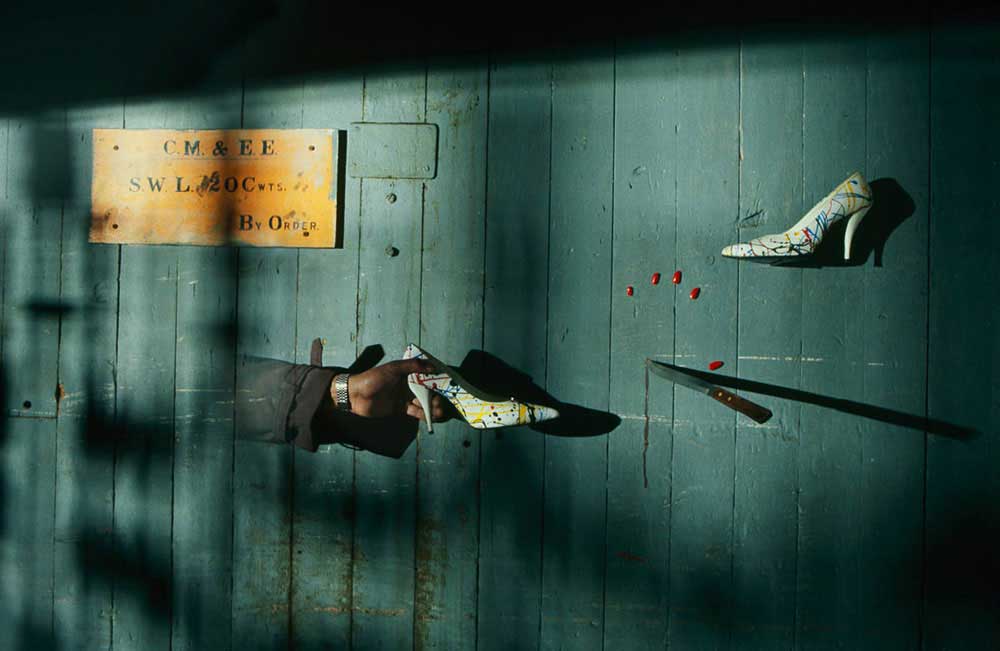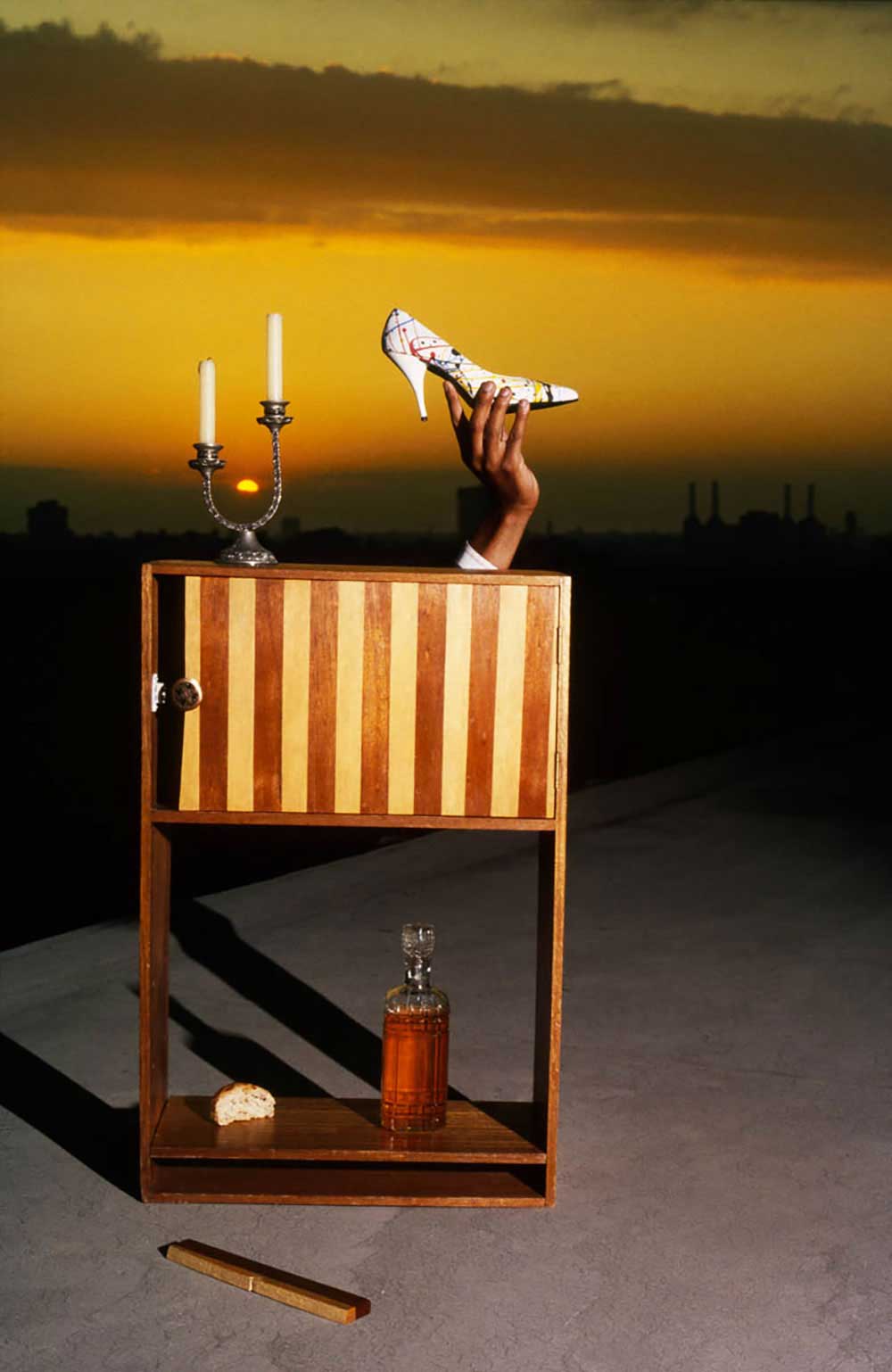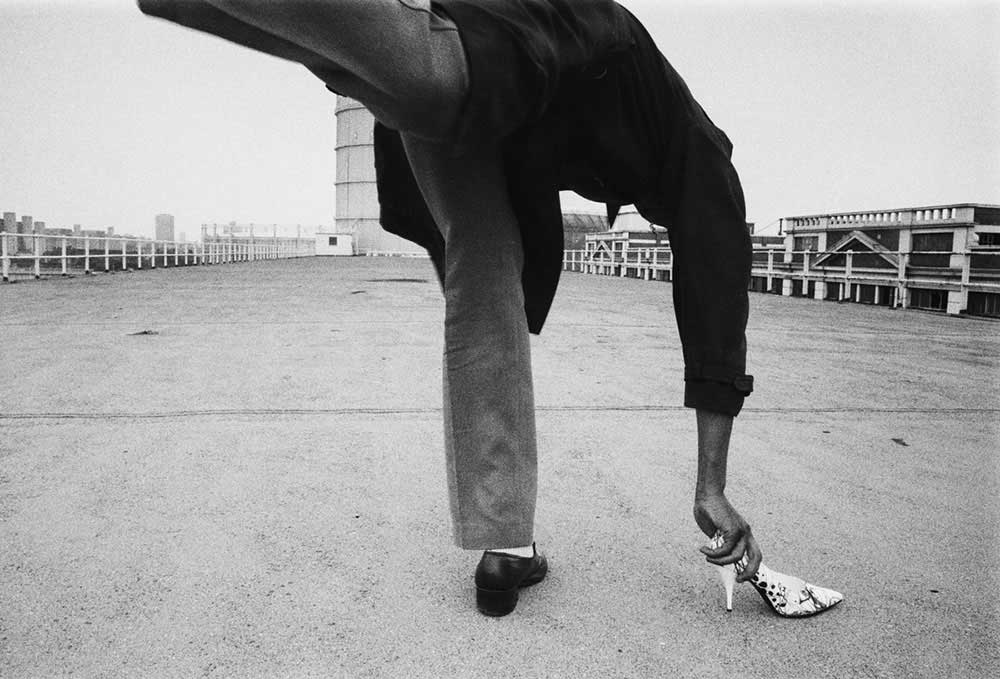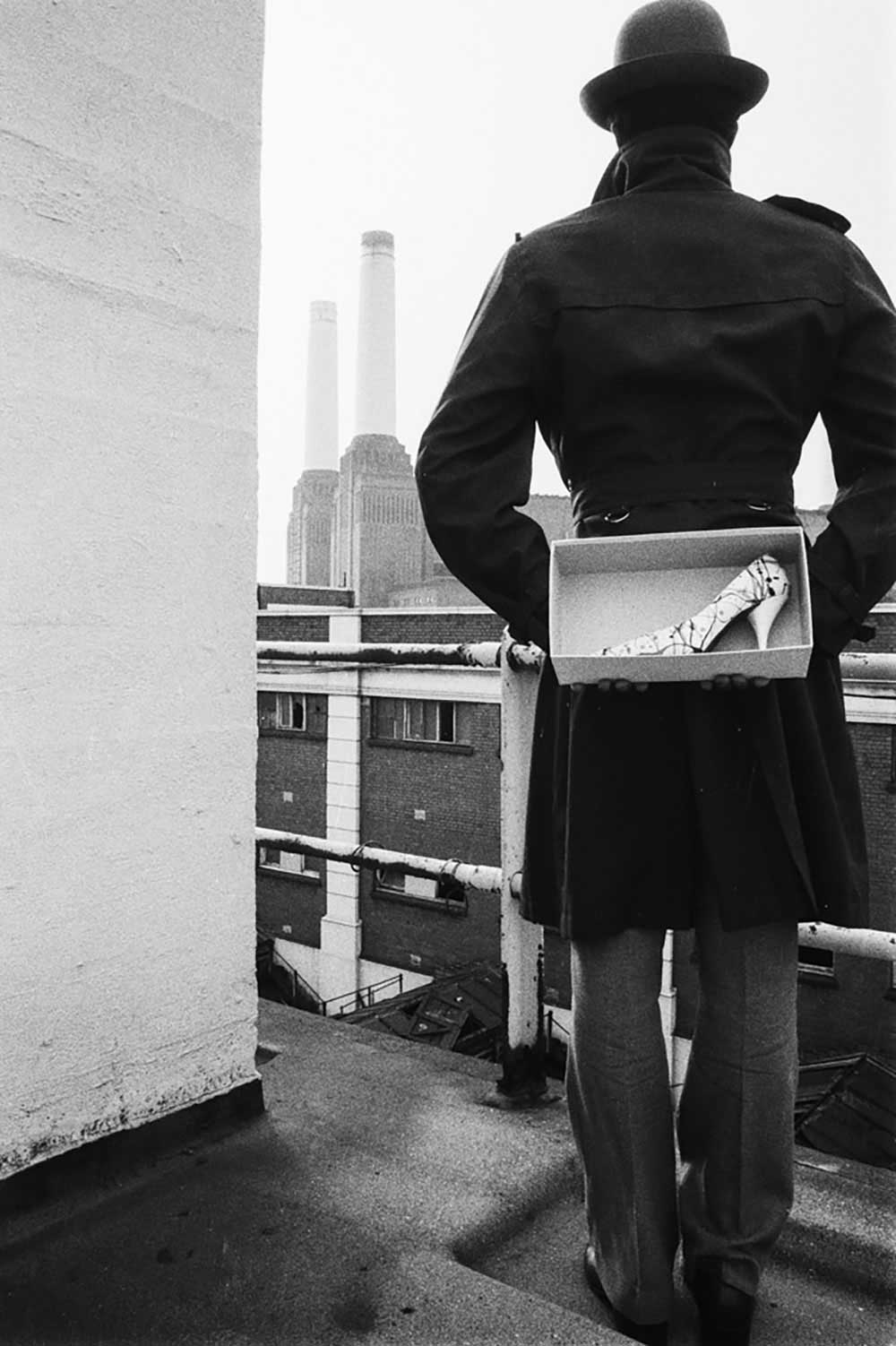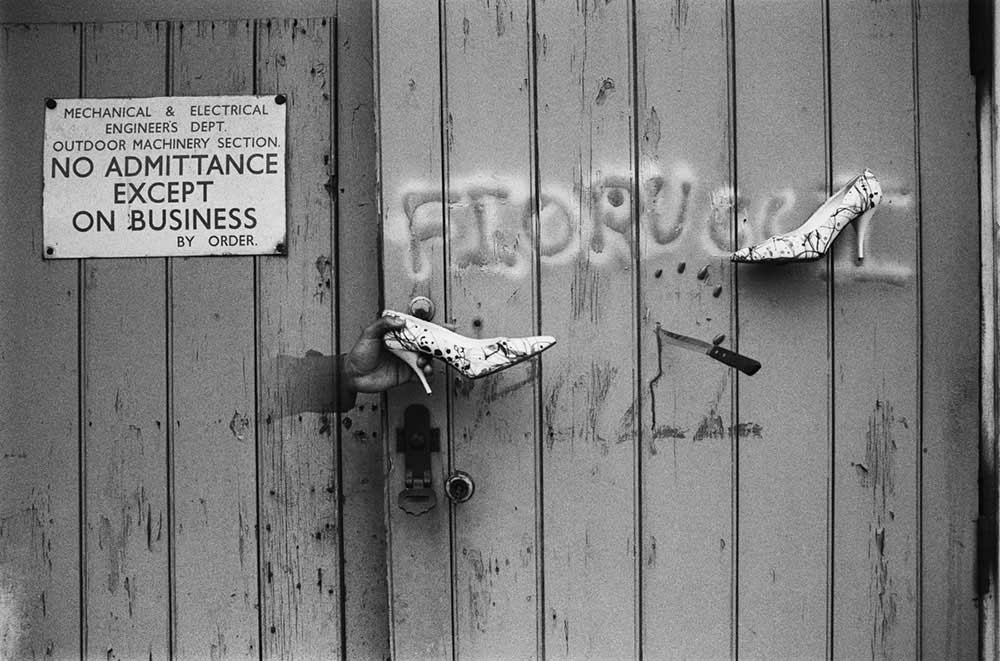I once won the Vogue/Sotheby’s Cecil Beaton Award, a competition for young photographers with a series I shot of a shoe. They were among the first pictures I took in what was to become my new style.
A Jackson Pollock patterned shoe is suspended on a wall of weathered boards, the shadowy orange evening light projects the shadow of a man in a hat and raincoat reaching for the shoe. In a flash this picture throws up a story that the viewer is coaxed to resolve. I have supplied you with the narrative elements please finish it off for me. There is something attracting and repelling at the same time about the picture. Maybe it will help if you know that the title of the picture is The Fetish III: The Dream of the Masturbator. I had conjured the “unresolved picture”, something that has stayed with me even to this day. It is the summer of 1984 and eighteen months after taking up photography I have found my real style as a photographer.
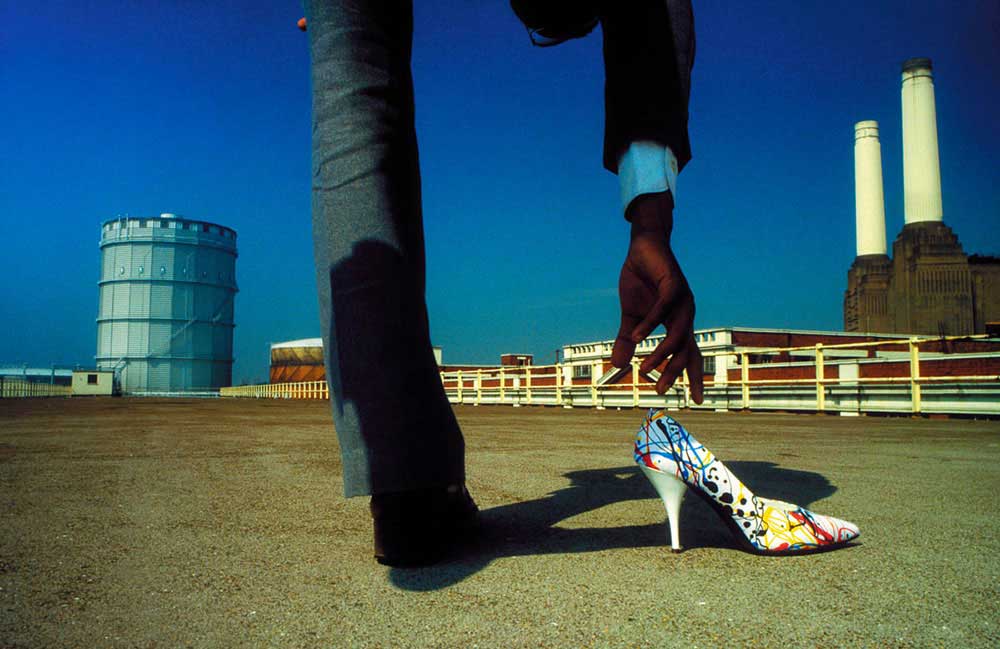
The work is as dark and as troubled as I am at the time. I am trying to resolve inner turmoil by putting ideas down on film but it is not cathartic, quite the opposite, in fact, it forces me to turn inward, a place where I am unhappy to be. I like the pictures though, I like being on the imaginative edge, I like photographing outdoors, I like these derelict buildings next to Battersea Power Station which I use as an open air studio, I like the warm evening light and have determined to use the long shadows thrown by a westering sun, I like the view of the River Thames from the rooftops – as a result there are plenty of blue skies in my work, I like the fact that nearly all the pictures I set out to take, work. I generally take three frames of each set-up which I bracket and develop the slides at home myself in the kitchen sink because I have no money. The first glimpse of the wet milky slides is exciting, it is also surprising. The camera sometimes picks up things I did not know were there. Unlike painting, which you have to abandon because you reach a point where the next stroke will be too much, the transparency hits you with direct surprise. Voilà! There it is. It either works or fails.
Before I take the first pictures of my new style, I have already created it in my head and sketched it on paper. I create a world in my own image. In cityscapes of oblique lighting, dark shadows, acid Technicolor and surrealist elements, strange people enact curious events. I become a fabulist, concocting a series of wilfully inconclusive and unsettling narratives or what I term ‘events’. I have kept the plausible topographical faithfulness of the photograph and have imbued it with an oneirical dimension filled with a sense of unease. The work is rendered with slickness, but it is only to set up the audience for the ambush – the menace of the shadow, or the knife, or the couple who in their passionate abandon may fall from the edge of the roof to their ruin. There is an alienating sense of tension and a pervading unhealthiness in these early pictures. I deliberately turn people into ciphers or objects. I crop out faces or mask them or use shadows to create menace. I want to become an object myself and I appear in many of these early pictures.
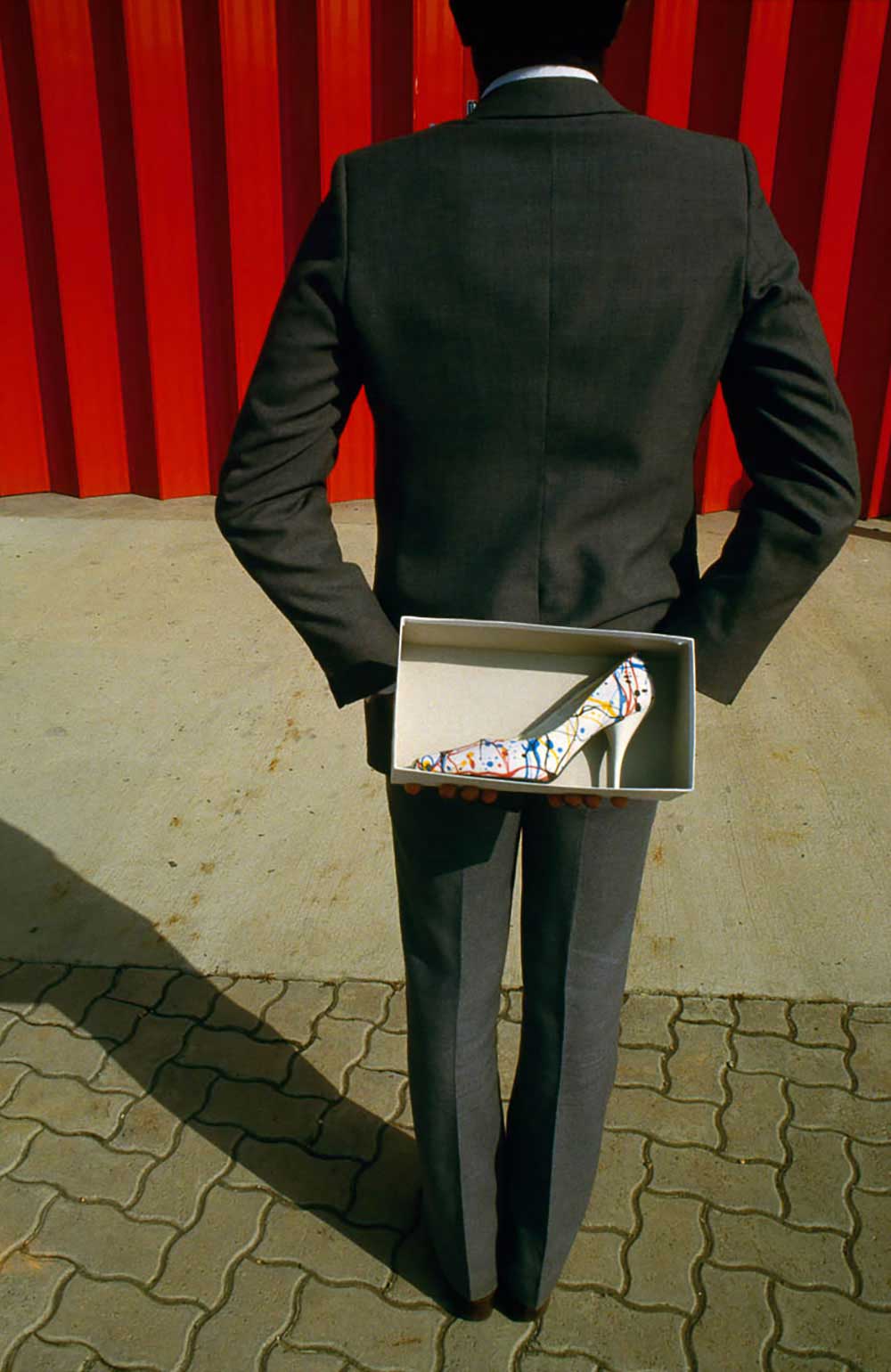
The previous year I had declared myself an impressionist. This year I I wanted to be a surrealist but I had not taken any surreal pictures yet. The series started with the idea of a man standing on one leg, in the act of picking up something. What that object should be, I had no idea but it should have some resonance or deep meaning. I phoned the Fiorucci store in Knightsbridge, London and asked if I could borrow some clothes. They agreed. While in the basement, I saw the shoes and decided that this would be the object.
I brought the shoes home and held them, turning them over in my hands to observe their shape and texture. I wanted to feel the picture. I had never given women’s shoes much thought before but thought the shape rather elegant and could see why a stiletto was such a classic shape. For the first picture, which I needed close to the ground as possible, I reversed the column of the tripod and hung the camera upside down. The first and last time I have ever done so. I woman on her balcony in a block of flats across the road spotted me, went in and got her binoculars, while I was practising standing on one leg in preparation. It made me feel very self-conscious and foolish. I shot it at midday and offset the high colour temperature with a polarising and a warm up filter. I used an aperture of f16.5. My new style was going to be shot mostly on a 28mm and I wanted everything in focus from the front to the back of the frame. The background was going to be nearly as important as what was going on in the foreground. Back then just like now, there was a fashion for long wide-open lenses to blur the background. I deliberately rejected that and selected the opposite way. I was very satisfied with the result and decided there couldn’t be just one definitive photograph of the shoe and I should take some more. It turned into a project. I shot three the first year and one per year for the next three years. The title, The Two Towers, was a nod to Tolkien.
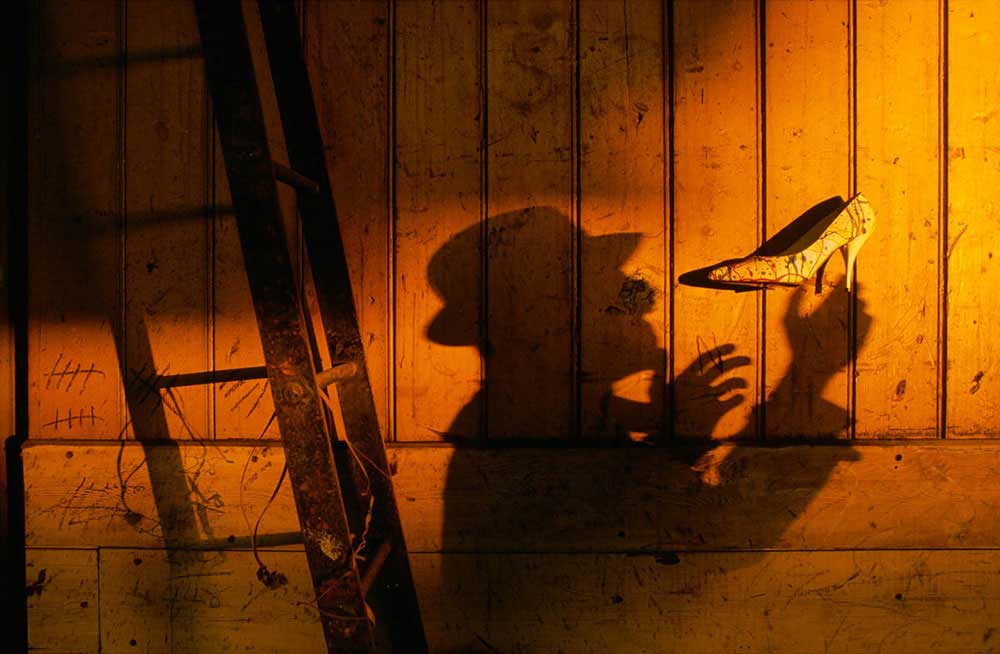
Not far away from the power station was a large Post Office sorting office and this is where I took, The shrine. I observed the transition of different patterns and colour and thought it would make an interesting backdrop.
I would pick my days to go to the power station and would go normally on sunny evenings, when there would be long shadows in the warm light. I was packing up ready to go when I turned and saw the light hitting the building through a hole in the awning that covered the goods yard platform. It was late and the sun was lowering quickly. I knew that I had to work urgently. I hurriedly to set up the camera and hammered in two nails to hold up the shoe and worked the shadow a bit. This was the penultimate shot before the light passed the hole in the awning and faded. That is how I captured The Dream of the Masturbator, which was a nod to Dali’s, The Great Masturbator.
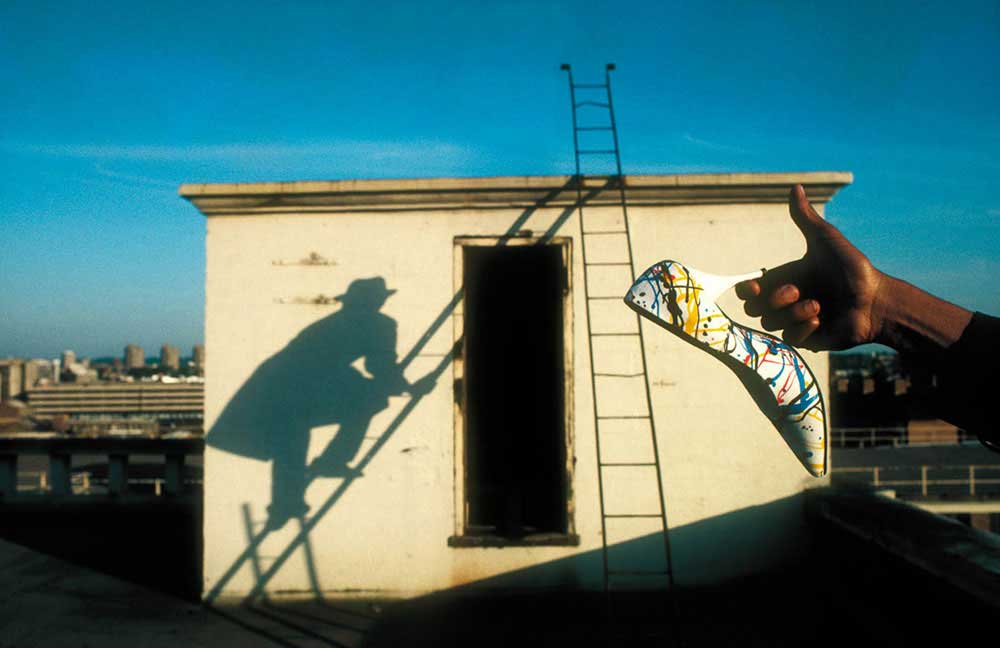
The following year I shot one of my first nudes in the doorway on top of this building. When I developed it, it was alright but there was something missing. It violated the main rule that I had imposed upon myself. That was, there had to be something surreal or interesting happening in each photo. I stared and stared at it and came up with the idea of the shadow of a man climbing the shadow of the ladder. I could not get the model back and decided to make it part of my fetish series. I had to wait two or three weeks to get the right light again. I achieved the effect with a in-camera double exposure which I explained how to do in another article.
Many years later, I was in pain in my doctor’s waiting room. I picked up an interior décor magazine. In it was an Italian advert showing long curtains and next to them was the shadow of a man with a fedora hat and a trench coat climbing a ladder. I thought the stance looked very much like my shadow. I wondered where they could possibly have seen my picture. I then remembered it was in my first book, Bernadinism: How to Dominate Men and Subjugate Women, that was published worldwide. I could not be bothered. Years later, I added the shadow to the nude digitally to make it like I had first imagined.
The Fetish V: Hand and Knife Expressing the Sentiment of Love Are Metamorphosed into a Sundial Illumined by the light of the Moon, Whilst the Shade of Allessandro Valente Sings “Non Piangere Lui” from Turandot By Puccini
The Fetish V, was shot in a derelict goods lift. I placed a flash outside the concertina doors to create the shadowy lighting.
With the last one, Eucharistic Altar, when I decided to enter the competition, I did one more picture. It was shot on the rooftop of my building and you can see the silhouette of Battersea Power Station in the skyline. I wanted to symbolise the blood and the body with the wine and the bread. I had made the cupboard for a woodwork school exam and it was the only good thing I ever made. While moving it, it fell on its front and part of the door fell off. I left it in because I thought it might be symbolic of something. I mounted my images and handmade a marble paper covered box for them and stuck a picture of Christ on the front.
While scanning my work during lockdown, I came across these black and white images I had totally forgotten about. I thought I had gone straight to the colour pictures but it transpired I had essayed them before that. I had shot some on an overcast day, then dissected what was wrong with them. I was obviously dissatisfied with the composition of the man on one leg. The camera position was too high and the body was an ugly shape. The hand on the shoe was inelegant and the background all wrong. For the second, there were some alright elements in it but it was not really singing. The trouser leg was messy and the shoebox tilted too much. It is hard to adjust for these details when you are the one in the picture. Overall, I thought it would be best to lose the hat and coat. The third one was fine and I merely recreated it in the goods lift.
I was delighted to have won but dismayed to discover they were not having an exhibition for the finalists. The previous year they had an exhibition at the Photographer’s Gallery, London, that I had seen. My highest ambition entering the competition, was to just get in the exhibition and get influential eyes, on my work. I was disappointed and vexed and the money for winning was little recompense. It was a damp squib and career-wise nothing happened. I wrote to them and virtually begged them for some work. I then got to do some cars and still lives for Vogue, then I worked for Tatler, another Condé Nast publication. I remember shooting rug dealers with the eccentric and enjoyable, Isabella Blow, who went on to discover the fashion designer, Alexander McQueen. Both are now suicides, I am sorry to say. After that I did some British GQ, which was just starting. I finally began to get some traction thereafter.
Alva Bernadine
Alva Bernadine makes photographs and films. By using themes such as surrealism, sexuality and violence, Bernadine touches various overlapping topics and strategies. Several reoccurring subject matters can be recognised, such as mirrors, shadows, optical effects and representations of the female form. The work is filled with invented surreal scenarios, witty events, troubling scenes from movies that were never made and almost hallucinatory images that invoke narrative, prompting you to imagine what came before or what is about to happen. They are not only about desire but the problems that go with it. Bernadine was born in Grenada, West Indies and grew up on the outskirts of London. He won the Vogue/Sotheby’s Cecil Beaton Award as a young photographer and has since worked for many prestigious magazines and became Erotic Photographer of the Year for his first book, Bernadinism: How to Dominate Men and Subjugate Women.



